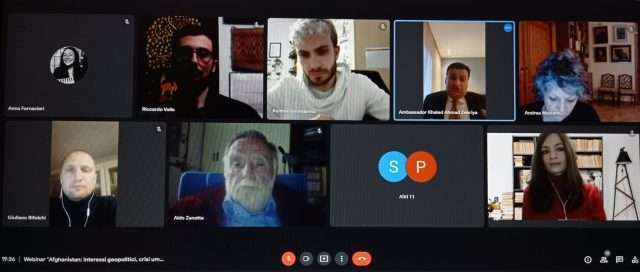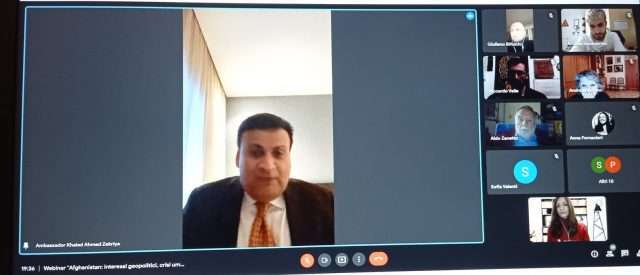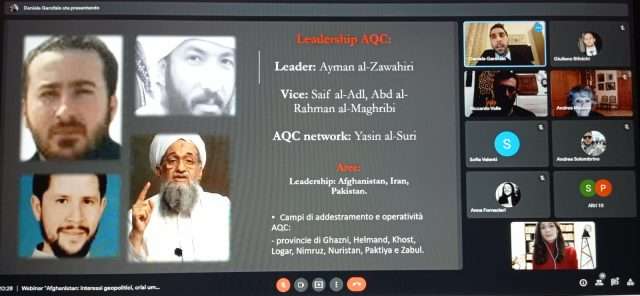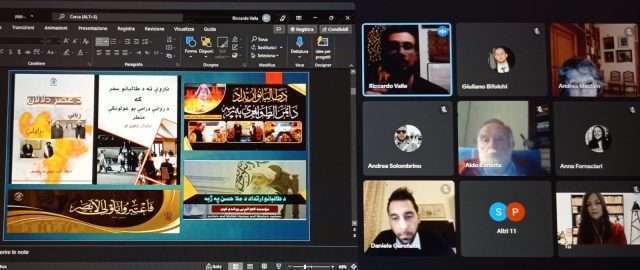Summary of the Webinar “Afghanistan: geopolitical interests, humanitarian crisis and security”

On April 6th, 2022, SpecialEurasia organised the webinar “Afghanistan: geopolitical interests, humanitarian crisis and security” to address the Italian public opinion on the current situation of the Afghan people after the U.S. troops’ withdrawal and the Taliban’s seize of power.
This event was part of SpecialEurasia’s special project titled “Afghanistan crisis“, whose purpose is to monitor geopolitical dynamics, regional and international actors’ interests in Afghanistan, local social situation and humanitarian crisis and investigate threats coming from jihadist propaganda and terrorist groups.
Giuliano Bifolchi, Research Manager at SpecialEurasia, moderated the webinar whose speakers were H.E. Khaled Ahmad Zekriya, Ambassador of the Islamic Republic of Afghanistan in Italy, Silvia Boltuc, Managing Director of SpecialEurasia, Daniele Garofalo and Riccardo Valle, risk analysts specialised in terrorist and jihadist propaganda and managers of SpecialEurasia’s special projects “Monitoring Jihadist Propaganda & Terrorism“.

H.E. Khaled Ahmad Zekriya gave the first speech focusing attention on different issues related to Afghanistan. Indeed, it is undeniable that since the Taliban took power, the Afghan population has experienced a vast humanitarian crisis mixed with socioeconomic problems and security threats such as terrorist attacks. Looking at the future of the country, Zekria stated that there are three options for Afghanistan:
- leaving Afghanistan at its destiny with the Taliban without international recognition and support and financial investments, which will result in a humanitarian disaster
- supporting the National Resistance Front of Afghanistan in its fight against the Taliban whose possible consequence could be another civil war in the country and the reorganisation of the Taliban;
- attempting to create a comprehensive coalition Government in the country which will also include the Taliban considering that they are part of the Afghan society.
According to Zekriya, the Taliban’s success in Afghanistan depends on the fact that the Taliban distribute the dividend to their ‘affiliates’: for instance, several policemen decided to change their side in favour of the Taliban because of the higher salary. Regarding the Taliban’s condemnation and the abolition of opium crops, the Ambassador noted that it is a Taliban strategy to seize those territories where people cultivate opium fields that are not under their control. Since the U.S. troops’ withdrawal from Afghanistan, the Afghan people practically ‘hate’ the United States because they abandoned them. By contrast, the Afghan perception of Europe, particularly Italy, is positive. This means that in the future, the European Union led by Italy might play a huger role in the country.
The Ambassador informed the webinar participants that the Taliban had used double propaganda: abroad, they promote their will to protect women’s rights and allow female education, but in Afghanistan, they usually invited terrorist groups to strengthen their power and commit atrocities against the civilians to remind to the Afghans possible future consequences for any opposition.

In her presentation titled “Why Afghanistan? Natural resources, economic corridors and pipelines“, Silvia Boltuc noted that located in the middle of Eurasia, Afghanistan has a unique geographic location that once placed the country at the centre of historic trade routes, such as the Lapis Lazuli Corridor, which dates back to 2600 BC.
The value of Afghanistan’s mineral resources is estimated to be between 1 trillion and 3 trillion dollars. In addition to large quantities of precious gems and gold, the country has the largest copper mine globally. Although the Afghan Constitution specified that the state possessed all the mineral resources, with the rise of the Mujahideen, the Taliban and other armed groups, part of this wealth has supported the activity of the rebels. Furthermore, a Pentagon report defined Afghanistan as “the Saudi Arabia of lithium”. The European Union included lithium among the 30 raw materials described as “critical” for its energy independence. According to the International Energy Agency (IEA), the world demand for lithium is expected to grow more than 40 times in the coming decades since it is essential for the electric battery industry. Afghanistan also has 1.5 million tons of rare earth, 17 minerals indispensable for technological artefacts: computers, video screens, smartphones, cameras and optical fibres. The subsoil also houses at least 60 million tons of copper, necessary for producing electrical cables and solar panels. The country is also an extensive reservoir of oil and gas.
Illicit channels represent the primary sources of funding for local factions. As emerges from a UN report, in 2017, illegal trade reached 1.4 billion dollars, with over 10.000 tons of production. One of the most involved foreign actors in Taliban-ruled Afghanistan is China. China needs a stable Afghanistan to guarantee security in Xinjiang’s neighbouring region, inhabited by the Uighur population. The Uighurs, some of whom are fighting in the ranks of the Islamic State, could arm themselves and return to China with terrorist intent.
Moreover, Afghanistan is the shortest way to reach the markets of Central Asia and Iran, and from there, the Gulf, the Caucasus and Europe. The alternative route, the sea route, is longer, more expensive and less safe, as it is patrolled by the countries of the Quad: Japan, Australia, United States and India. Finally, the Taliban needs Beijing’s investments and skills to extract copper from the largest mine globally and earn money since the government’s assets are frozen. China’s strategy will be to connect Kabul to Peshawar and, thus, to the China-Pakistan Economic Corridor (CPEC) till the Gwadar port. An alternative earning possibility for the Taliban might be transit tax. Recently, Kabul discussed ultimate the TAPI gas pipeline project with Russian representatives and, on April 1st, with Turkmenistan and India.

Daniele Garofalo gave a presentation titled “Security scenarios in Afghanistan: al-Qaeda, smaller jihadist groups and the Resistance“, in which he highlighted that some eight months after the seizure of Kabul, Taliban-led Afghanistan remains a critical area from a security perspective. The Islamic Emirate’s promises and assertions to ban al-Qaeda (AQ) from its territory have not been fulfilled, and the country remains a hotbed for local and global jihadism. Al-Qaeda has fought alongside the Taliban in recent years without the group ever renouncing their alliance with AQ, with whom there has always been a close relationship, generational, family and marriage ties. The Taliban’s annual spring operations have always received support from al-Qaeda, which has also helped the Taliban train new militants at a logistical and operational level and produce improvised explosive devices (IEDs). The leadership of al-Qaeda Central (AQC) remains firmly entrenched in Afghanistan and continues the low-profile strategy pursued by its leader Ayman al-Zawahiri (we confirmed on April 5th, 2022, that he is still alive). AQC does not need to operate in Afghanistan and continues to do so through its senior leaders, notably Saif al-Adl and Abd al-Rahman al Maghribi, from other areas such as the former Pakistani tribal areas and Iran.
Furthermore, AQC, due to the way it is structured (substantial decentralisation), does not need to operate necessarily from Afghanistan but could do so in any area. Together with al-Qaeda Central (AQC), other groups allied to the Afghan Taliban and AQ have also operated and operate in the country, taking refuge and training, such as the Turkestan Islamic Party (TIP), a group with a Uighur majority, the Islamic Jihad Union (IJU), a group with an Uzbek majority, and Jama’at Ansarullah, a group with a Tajik majority.
In August, after the fall of Kabul, many politicians and government employees, cadres, and members of the NDS, ANA and ANDSF fled to Panjshir. Under the leadership of Ahmad Massoud Jr, it was decided to announce the resistance and establish the National Resistance Front (NRF). After a difficult initial phase, the NRF embarked on a new guerrilla warfare and ambushes strategy, which allowed it to grow and stabilise. To date, guerrilla groups and cells operating under the NRF banner and sworn allegiance to Massoud Jr. are present in 24 provinces, and the NRF has taken factual control of several districts in 12 provinces from the Taliban. In recent months, several guerrilla groups in close contact with the NRF have emerged, such as Afghanistan Freedom Front (AFF) in the northern provinces; Atta Muhammad Noor’s Supreme Council of Resistance (SCR) operating in Sar-e-Pol, Samangan, Parwan, Faryab and Kabul provinces; the National Liberation Front (NFL) operating in Baghlan and Kabul provinces; the Hazaristan Resistance Front, led by Commander Alipour as operating in Wardak and Ghazni provinces; the Freedom and Democracy Front operating in the province of Ghazni; the Andarab Resistance Front operating in the provinces of Baghlan and the lateral valleys of Panjshir; the Khalid ibn al-Walid Front operating in Panjshir and finally the Ghazdomak Scorpion Unit and the Death Squad operating in the province of Nangarhar. In March 2022, the NRF claimed to have conducted over 650 attacks in a video last week. Leader Massoud said that the NRF’s operations would continue to grow due to the strong popular support it receives in the northern provinces of Afghanistan.

Riccardo Valle presented his research titled “Islamist narrative in Afghanistan and Pakistan under the new Islamic Emirate. The cases of Islamic State in Khurasan, al-Qaeda in the Indian Subcontinent, and Tehreek-e-Taliban Pakistan.” The return of the Taliban to power in Kabul and the subsequent formation of the government of the Islamic Emirate had several impacts on local, regional groups which are either aligned with the Taliban or their enemies, namely the Pakistani Taliban (TTP) and the local branch of al-Qaeda (AQIS) and on the other hand the local province of the Islamic State (ISKP). This prompted such groups to react to the changing scenario in the AfPak region in different ways, with ISKP boosting its propaganda output against the Taliban, AQIS quietly praising the new government, and the TTP taking lessons from their Afghan brethren. In its propaganda production, ISKP is constantly lashing out against the Taliban with the ultimate goal of discrediting and delegitimising the group both as a jihadi movement and as a government.
For this reason, ISKP literature focuses on the Taliban as a nationalist, monoethnic (Pashtun), secular and democratic, and Hanafi/Deobandi supremacist group, which is on the path of eradicating Salafism from Afghanistan. ISKP claims there is no difference between the Islamic Emirate and the former Islamic Republic, arguing that the Taliban are puppets in the hands of global and regional powers. To attract new recruits, the group is employing religious, political, social, ethnic, and sectarian narratives across the AfPak region, among Pashtun, Dari-speaking, Uzbek, and Tajik constituencies, calling for new martyrdom attacks during the month of Ramadan. On the other hand, AQIS is still working under the protection of the Taliban in Afghanistan. While previously, important AQ and AQIS leaders were killed in Taliban controlled territory – such as Asim Umar and Hussam Abd al-Rauf –current AQIS emir Osama Mahmood is supposed to be still active in Afghanistan. And even though AQIS is shifting its regional focus from Afghanistan to other regions – India, Pakistan, Kashmir, Bangladesh, and Burma –its propaganda constantly glorifies the decisions of the “New Islamic Emirate, Government of Allah, Nation of Allah”.
Finally, the TTP is also taking advantage of the victory of the Taliban, thanks to its deep ties with them, particularly with the current Minister of Interior, Sirajuddin Haqqani. Several TTP members imprisoned in Afghanistan were liberated by the Afghan Taliban, including its former deputy emir Maulvi Faqir. The TTP officially stated that the victory of the Taliban is an inspiration for the group to the extent that the TTP is launching its Ramadan offensive in Pakistan, similarly to the military operations previously conducted by the Afghan Taliban during their own insurgency. Moreover, the TTP is shaping its territorial administration following the model of the Afghan Taliban, creating several shadow provinces and local military commissions in the Khyber Pakhtunkhwa region.
Request the full SpecialEurasia report on Afghanistan by contacting our team at the following Link.
